One of the things people enjoy about birds, especially songbirds, is their lovely songs. This is true for those living further north who have to endure a long lonely winter that extends well into April and May. So hearing the sweet song of a white-throated sparrow or an American robin in April after months is a breath of fresh air.
The song marks the arrival of the season. Brighter, warmer days are coming.
Today we discuss some interesting facts about birds, like their singing habit, how they learn to sing, Oscines, Suboscines, and attracting a mate.
The dawn chorus:
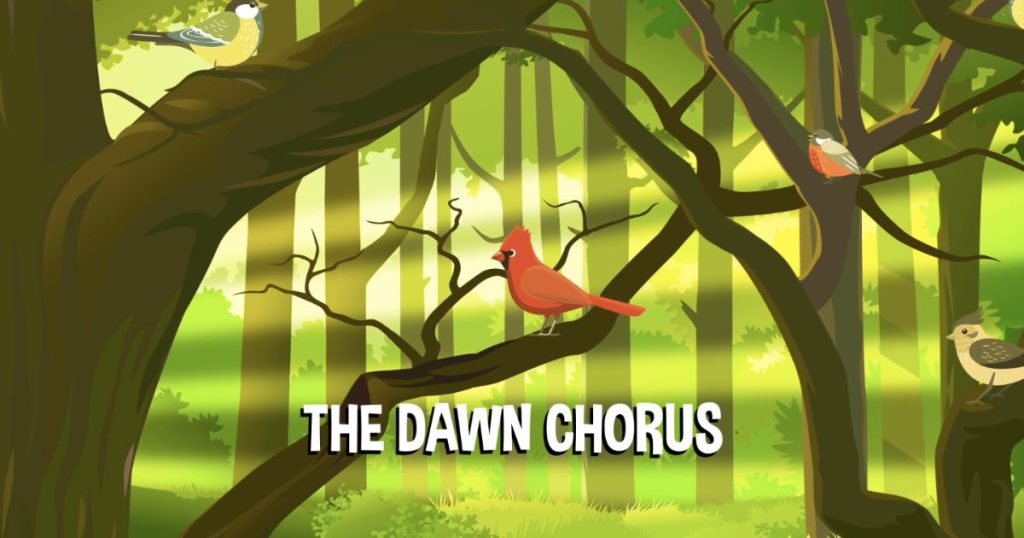
The early morning when seemingly every bird within earshot
sings the dawn chorus. It starts around 4:00 am and can last for several hours. But, of course, birds sing throughout the day.
But during the dawn chorus, their songs tend to be louder, livelier, and much more frequent.
At this very moment, somewhere on earth, the sun is rising, and a dawn chorus of birdsong welcomes the new day. This never‐ending avian symphony has been performed non‐stop for millions of years, yet our scientific understanding of avian biology still improves with every passing year.
But why do they do this?
Few theories suggest why they do this,
1
Attract a mate or warn other birds of their territory:
One idea is birds sing so early because it tends to be extra quiet, allowing their songs to travel further.

Without the hustle and bustle of the daytime, their songs would be easier for a mate to pick out. Early in the morning, birds have yet to have a healthy breakfast or time to warm up. If a male bird can still sing loudly and strongly in that time, it gives a clear message to other male birds that you are strong. Also, the better it sings, there is better advantage he has of being heard by other male competitors and, more importantly, females, as they need to attract the best mate and grab the best territory to raise babies. So waking up early as possible to achieve their goals makes loads of sense.
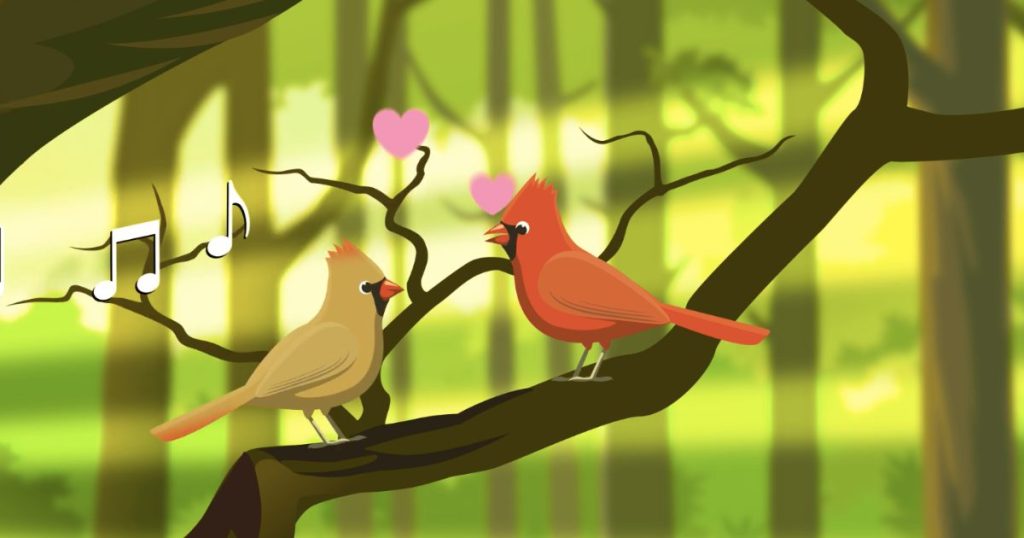
Basically, it’s like a beautiful singsong version of you look beautiful or get off my branch. So those songs are less about crooning and showing other birds how fit and healthy they are.
2
Another theory is the darker hours of the early morning, birds can’t do any of their other bird chores, like foraging for food. So they use that time to get better at singing instead. Recently, a new theory has been found that the early morning vocal warm-up works wonders for their singing. So like how opera singers warm up before a show to make sure they sing at their best, birds, too, seem to warm up before the morning begins.
Bird’s effort to sing:
To test the warm-up hypothesis, biologist professor Steven Nowicki and biologist Susan Peters of duke university recorded some male swamp sparrows between 3 am and noon, for 2-3 mornings each. If you want to hear one, you can visit the allaboutbirds.com website. Their call is described as a simple trill of up to five notes that repeat around five to ten times a second.
While bird song may seem effortless, it isn’t. As researcher Jason dean explained, a bird producing a song requires balancing competing demands of speed and dexterity. Birds switch between notes by opening and closing their beaks.
To switch from low to high and back down again, a bird must precisely coordinate the movements of its beak and voice box with each breath.
Bird’s singing process:
Analysis of the recordings showed that they start off taking with a more limited range, then only they start to nail their songs, picking the tempo and reaching for higher and lower pitch, just after dawn, after hundreds of takes, the more they warmed up, the better they got.
Researchers discovered that warming up helped them sing more difficult songs later in the morning. So warming up helps to get their blood flowing and temperature rising to meet the physical demands of singing.
To our ears, we may not be able to notice the subtle differences between competing male singers, but it’s likely quite noticeable for female birds. For them, a well-sung song is more appealing than a rusty one, not to mention more threatening to male competitors because it takes a healthy, strong, energetic male to sing well, so that must be one really big reason why birds start singing so darn early on those spring mornings.
Next spring, when the birds return and start singing outside your window very early in the morning, keeping you up, remember they are putting in a huge effort to attract a mate and deter competitors.
How birds learn singing and the science behind:
The process by which songbirds learn to sing unfolds in stages. A young songbird first memorizes a song, which it can do as early as 15–20 days of age. Days, months, or even a year later, the bird recalls that early memory as it practices singing and repeatedly tries to produce an imitation of what it remembers. Listening carefully to its practice songs, the bird makes successive corrections to the practice sounds that eventually result in a near‐perfect copy of the remembered song.
Nestlings of many species begin to practice singing shortly after leaving the nest, often at about three weeks of age. The earliest practice, known as subsong, is barely detectable, even by someone listening very carefully from a short distance away.
This is followed by intensive practice, where they develop a plastic song still in progress, with parts of the song still being improved. Like human babies, young birds babble when trying to learn the songs, mastering each note or trill. This practice phase is known as the sensorimotor period.
Each young male songbird must master a vocabulary of about 16 different song types copied from his adult male neighbors. Eventually, he can choose one of those 16 song types and sing it 20–50 times in succession, giving each rendition crisply and consistently, with no mistakes or wavering. Then he will introduce another of the 16 songs, and eventually another, until slowly, methodically, over several hours, he has worked his way through his entire song repertoire.
But the practicing young wren gets much of this wrong. Like a babbling human toddler, he takes bits of sound out of context and strings them together in a continuous, non-sensical sequence. As a result, the sounds lack the crispness and confidence of adult vocalizations, and no two attempts at the same sound are alike. Eventually, however, these young ones will be as competent as their father, just as we master spoken language.
Wherever you live, chances are you can hear young birds practicing if you listen very carefully during times of the year when juvenile birds become independent. Practice songs are less structured and more rambling than adult male songs.
Finally, the song becomes crystallized when they master it. In some birds, known as seasonal species, once a song becomes crystalized, that is well set like a crystal.
But other species are open-ended learners. They can repeat this cycle of sensory to sensorimotor to the crystallized period over and over, letting their song change over time. This is most noticeable in species that are accomplished mimics, appropriating sounds from other species into an ever more complicated song.
Diversity of song development in songbirds
With well over 4000 species, it is difficult to generalize how “the songbird” develops its song. Perhaps the only valid general statement is that evidence of learning has been found in all songbird species studied to date. But how this learning occurs varies considerably among species.
Oscines vs Suboscines
Passerines, the perching birds, which include all the songbirds in the world, about half of the avian diversity, and some of the best vocal talent can be broadly broken into two groups, oscines, and suboscines. Suboscines and oscines together form the order Passeriformes.
The striking differences in song development between the oscine songbirds and suboscines are clearly illustrated by studies of song development in two very similar species found in eastern North America, the Alder and Willow Flycatchers. These two species are identical in appearance, and the only reliable way to identify them in the field is by their songs and calls: the Alder Flycatcher sings a song that sounds like “fee‐BEE‐o,” and the Willow Flycatcher sings a “FITZ‐bew” song.
Oscines:
The main distinction between the groups is in the syrinx, where birds make their sounds distinct from the vocal cords in mammals.
The difference between the two groups of passerines is in muscular attachments to this remarkable organ. The more specialized muscle attachments in oscines give them the distinctive ability to have sound lateralization meaning these birds can produce two different notes simultaneously.
This helps oscines the ability to make more fluid and musical songs, along with making sounds that are just bizarre.
Oscines are very successful and found worldwide; thus, despite their incredible anatomy, they are all the common songbirds you know: thrushes, warblers, sparrows, and blackbirds.
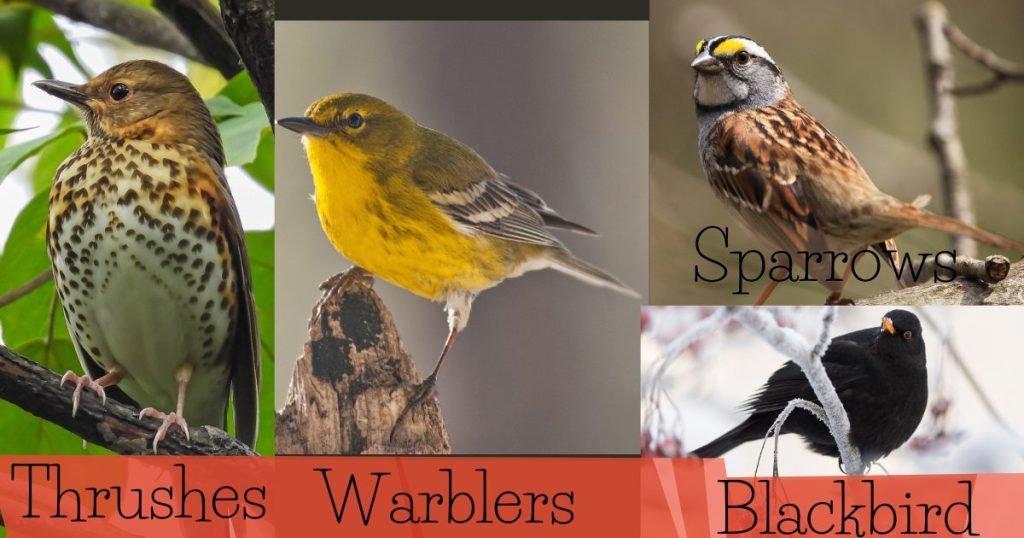
Suboscines
Suboscines, in contrast, are absent from many parts of the world. They are restricted to the tropics. In the Americas, they are far more diverse, with the tyrant flycatchers being a reasonably successful group of migrants to the temperate zones of North America.
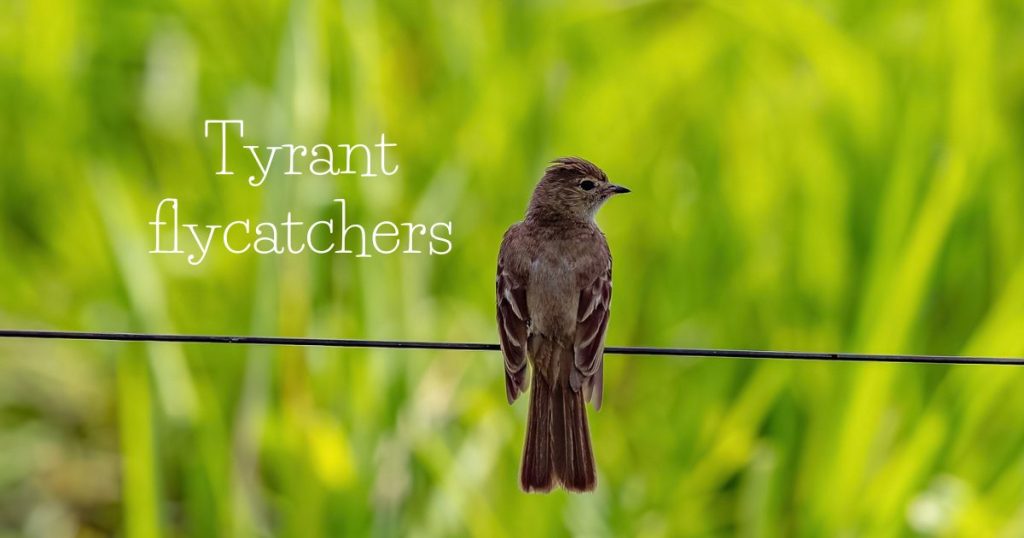
The neotropics, though, are the stronghold of these birds, with a high diversity of suboscine families: manakins, antbirds, ant thrush, and cotingas.
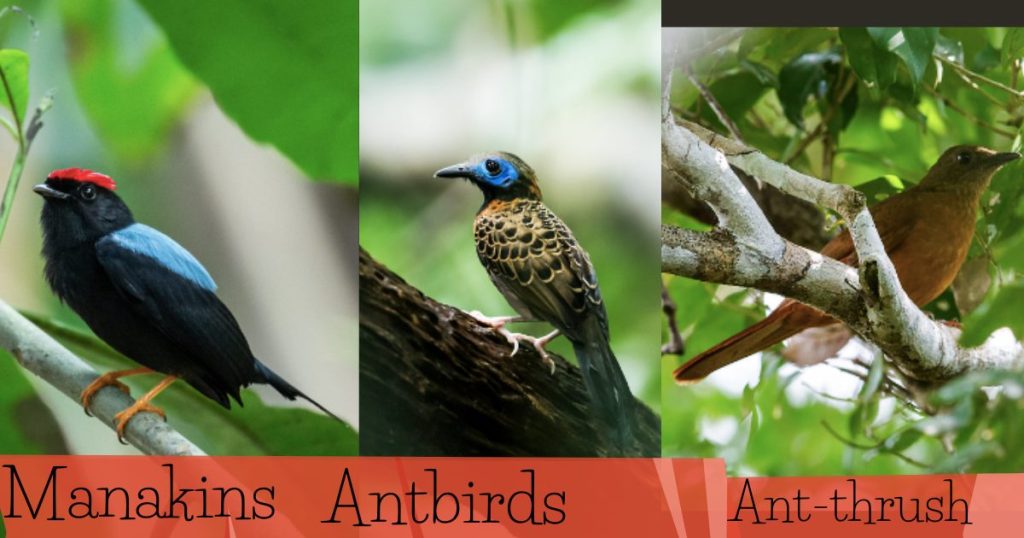
Unlike oscine songbirds, New World flycatchers know their songs instinctively. Being the most well-studied suboscines, this difference in learning methods is another commonly cited difference between these two groups of perching birds. Suboscines have their calls and songs innately. Oscines must learn. However, some suboscines, like parrots, songbirds, and hummingbirds, also show the ability to learn and change their song.
Cotingas are one such family of suboscines that show this learning ability. The three-wattled bellbird is a strange cotinga of Central America.
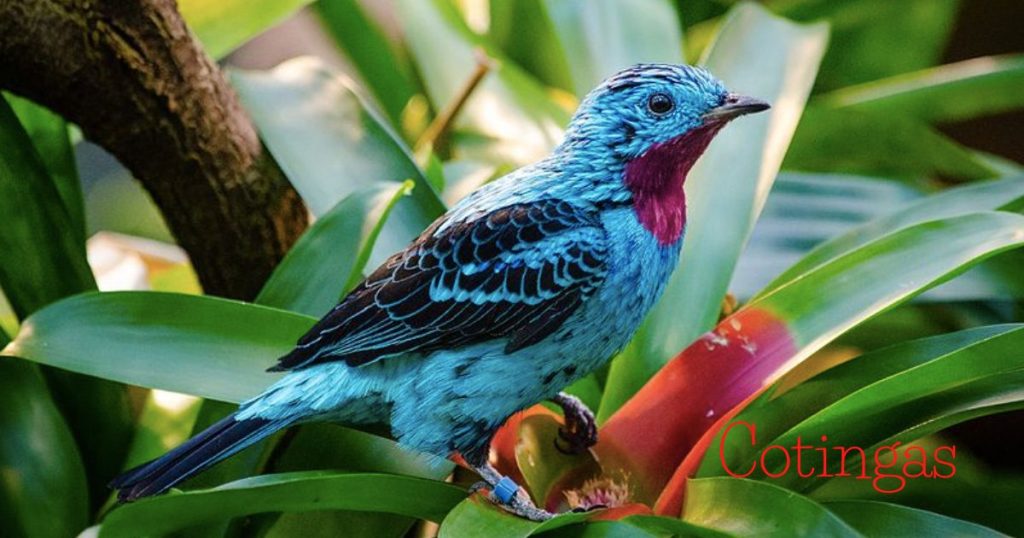
It belts out loud bonk calls that ring across the canopy of montane Costa Rican forests during its breeding season. Each year, this song, if it can be called that, changes slightly, shifting over the lifetime of a bellbird.
This means they must not only learn the song of the species but also subsequent shifts in the song each year.
Alpha Beta and Gamma birds:
In the same montane forests, another suboscine also seems to be able to alter its complex mating songs and calls. Long-tailed manakins have a very complex ritual involved in attracting a mate.
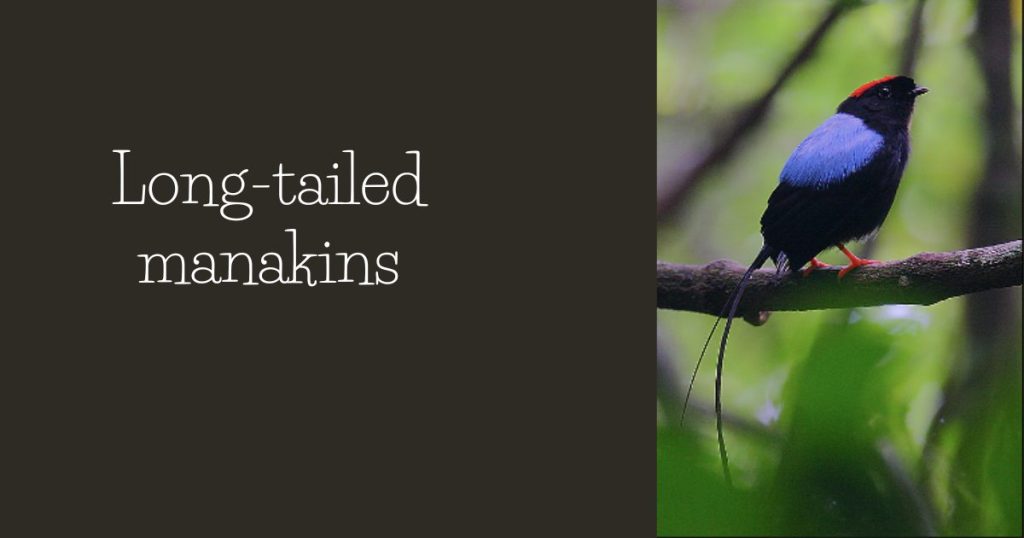
First, it requires two males working together, alpha and beta.
They must sing a duet of the Toledo call to bring females to the area. Then the two males move from the canopy where they sing to near the forest floor, where they do a dancing display. Then it moves into a silent flight show. If all these steps are executed perfectly, the alpha will get to mate with the female.
Young males spend most of their lives preparing for the few years they may get to be alpha. It is like an apprenticeship. The beta is the main apprentice, waiting for his master to die and ascend to take control of the court and have a chance to save his genes. Below the beta are gamma males.
Non‐vocal sounds
In addition to the songs and calls that dominate avian acoustic communication, birds produce various non‐vocal sounds. Some, such as the whooshing sound we hear when a flying bird passes nearby, are probably just side effects of a bird’s regular movements. However, many non-vocal bird sounds appear to be evolved signals that function in communication.
Woodpecker drumming, for example, occurs mainly during the breeding season, and drumming birds choose to drum on surfaces that yield especially loud and long‐lasting sounds when struck repeatedly. These observations hint that a woodpecker’s percussive performances generate long‐distance signals that function in territory defense or courtship, much like the songs of passerine birds.
How do woodpeckers produce sound?
The rapid drumming of a woodpecker is made possible by a suite of special anatomical features that allow it to bang its head forcefully on a tree many times per second without losing consciousness or sustaining brain damage. At least one non‐woodpecker species without these adaptations nonetheless manages to produce percussive sounds by using tools to strike hollow tree trunks.
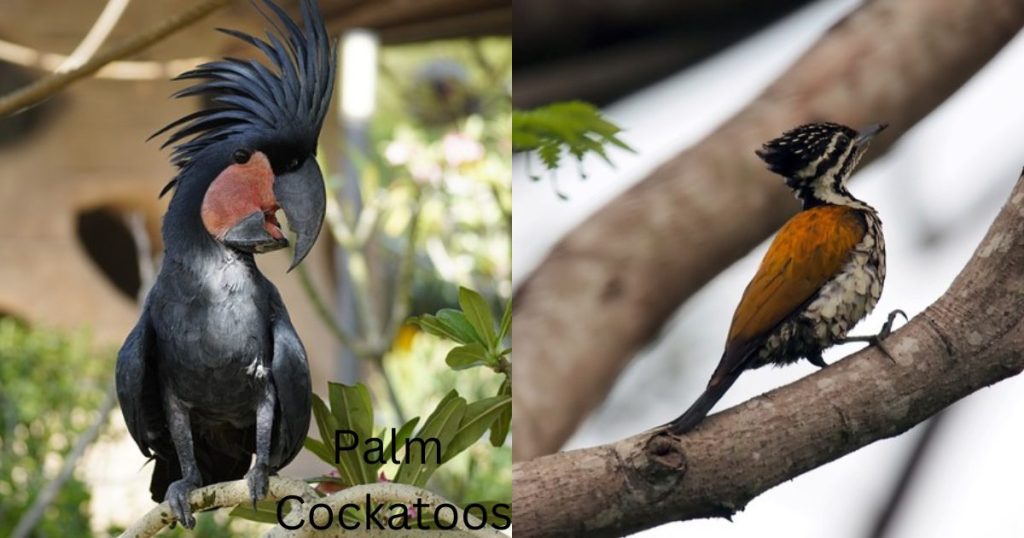
Palm Cockatoos in New Guinea and northern Australia use their bills to craft a drumstick from a small branch. The bird then grasps the stick with its foot and bangs it rhythmically against a hollow tree. The resulting drumming sound is audible to human listeners more than 100 meters away.
Non-vocal birds produce sound through feathers:
Many non‐vocal bird sounds are produced by feathers, most commonly by wing or tail feathers. For example, feathers are responsible for many of the sounds made by displaying hummingbirds and manakins and for those produced during the aerial courtship display of the American Woodcock. The Twitter audible during a displaying woodcock’s ascent is produced by air moving over its rapidly flapping wings and vibrating three specially modified, narrow wing feathers.